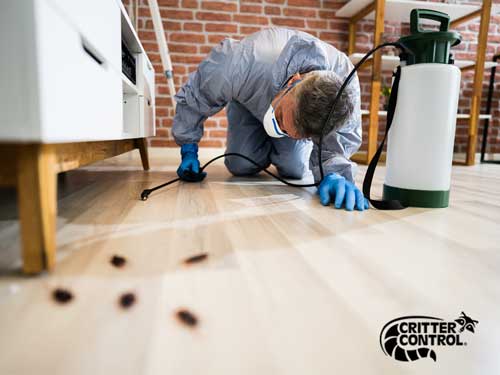Efficient A1 Bed Bug Treatment in Charlotte - Safe and Proven Techniques
Wiki Article
Bed Bug Therapy Malfunction: Contrasting Chemical Vs. Non-Chemical Solutions
In the realm of insect control, especially when handling the relentless issue of bed bugs, the option in between chemical and non-chemical treatment remedies can be a pivotal one. Both techniques provide distinctive advantages and drawbacks, influencing aspects such as effectiveness, safety and security factors to consider, and overall cost. By checking out the nuanced details of each technique, a more clear understanding of which course to seek in dealing with a bed pest problem can be achieved.Performance of Chemical Treatments
Chemical treatments for bed pest problems have actually been commonly acknowledged for their quick and potent efficiency in eliminating these parasites. When thinking about the performance of chemical therapies, it is crucial to understand that they can give a extensive and quick option to a bed pest trouble. Expert pest control experts usually depend on insecticides to target bed pests at numerous phases of their life process, consisting of grownups, eggs, and fairies. These chemicals commonly function by disrupting the bed bugs' nerve system, bring about paralysis and ultimate fatality.Additionally, chemical treatments have the advantage of supplying residual results, indicating that they can remain to eliminate bed insects even after the preliminary application. This residual action is specifically valuable in combating any possible re-infestations. Furthermore, the rapid activity of chemical therapies can bring relief to individuals dealing with severe bed insect problems, allowing them to restore control of their home promptly.
Safety Worries With Chemical Solutions
One crucial facet that requires careful factor to consider when using chemical solutions for bed pest treatment is ensuring the safety of residents and the setting. Exposure to specific chemicals utilized in bed bug therapies can lead to breathing concerns, skin inflammation, or various other unfavorable responses, especially in people with pre-existing conditions or sensitivities.In addition, the environmental influence of chemical solutions is another considerable consideration. Some chemicals used in bed insect treatments might be hazardous to beneficial bugs, wildlife, and environments if they seep into the soil or water supply. It is necessary to make use of chemical therapies sensibly, complying with safety and security standards, and thinking about less poisonous alternatives to reduce these dangers and make certain the efficient and risk-free monitoring of bed bug invasions.
Advantages of Non-Chemical Strategies
Considering the possible safety issues and ecological impact associated with chemical options for bed pest treatment, checking out non-chemical strategies provides a promising choice with several distinct advantages. Non-chemical treatments are eco friendly, as they do not add to air or water air pollution, making them a sustainable selection for insect control.Additionally, non-chemical remedies can be effective in targeting bed insects, consisting of hard-to-reach locations where chemical treatments might not penetrate - A1 exterminator charlotte nc. Techniques such as warmth treatment, vacuuming, heavy steam cleaning, and cushion coverings provide complete eradication without the use of damaging chemicals.
Limitations of Non-Chemical Treatments

Additionally, non-chemical treatments usually require numerous applications to attain effective removal. go to the website This can be taxing and may not constantly assure full removal of all bed pests and their eggs, particularly in hard-to-reach or covert areas.
Moreover, the success of non-chemical therapies heavily counts on correct implementation and thoroughness, which can be challenging for people without professional know-how. Inadequate application of non-chemical methods may lead to insufficient eradication, causing relentless problems and the need for extra therapies.
Therefore, while non-chemical therapies have their advantages, it is necessary to recognize these limitations and consider them when identifying the most effective method for handling bed bug infestations.
Expense Contrast: Chemical Vs. Non-Chemical Options
Offered the constraints connected with non-chemical therapies, an essential aspect to examine in the context of bed insect administration is the expense comparison between chemical and non-chemical options. Chemical treatments normally include the application of insecticides by professionals, which can range from $250 to $900 per space, depending upon the severity of the problem and the dimension of the area to be treated. In contrast, non-chemical therapies like warm treatment or heavy steam can be extra pricey, with expenses ranging from $1,000 to $6,000 for a whole home. While the preliminary expense of chemical treatments may appear reduced, multiple therapies may be required to totally get rid of the best pest control the invasion, potentially enhancing the overall cost. On the various other hand, non-chemical options might supply a much more sustainable and environmentally friendly service, although they can be cost-prohibitive for some people. Inevitably, when taking into consideration the expense of bed bug therapy options, it is very important to consider the in advance expenditures against the effectiveness and long-lasting sustainability of the chosen method.Verdict

Taking into consideration the potential safety worries and ecological influence connected with chemical options for bed insect therapy, discovering non-chemical methods provides a promising option with a number of distinctive benefits.Given the restrictions linked with non-chemical therapies, a vital facet to review in the context of bed insect monitoring is the cost contrast between chemical and non-chemical choices. In comparison, non-chemical treatments like warmth therapy or vapor can be more expensive, with costs varying from $1,000 to $6,000 for a whole home. While the first price of chemical therapies might appear reduced, multiple therapies might be called for to fully eliminate the problem, possibly enhancing the total cost.In final thought, when contrasting chemical and non-chemical bed insect therapy options, it is essential to think about efficiency, security, benefits, restrictions, and expense.
Report this wiki page